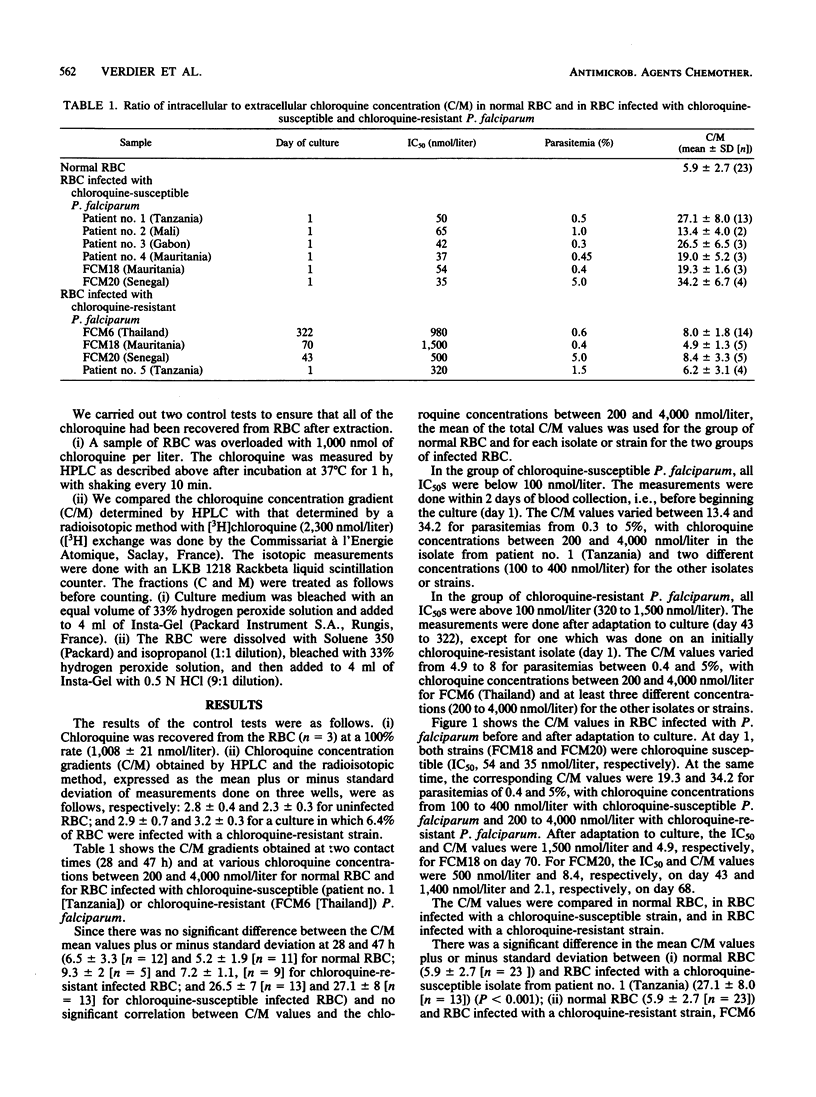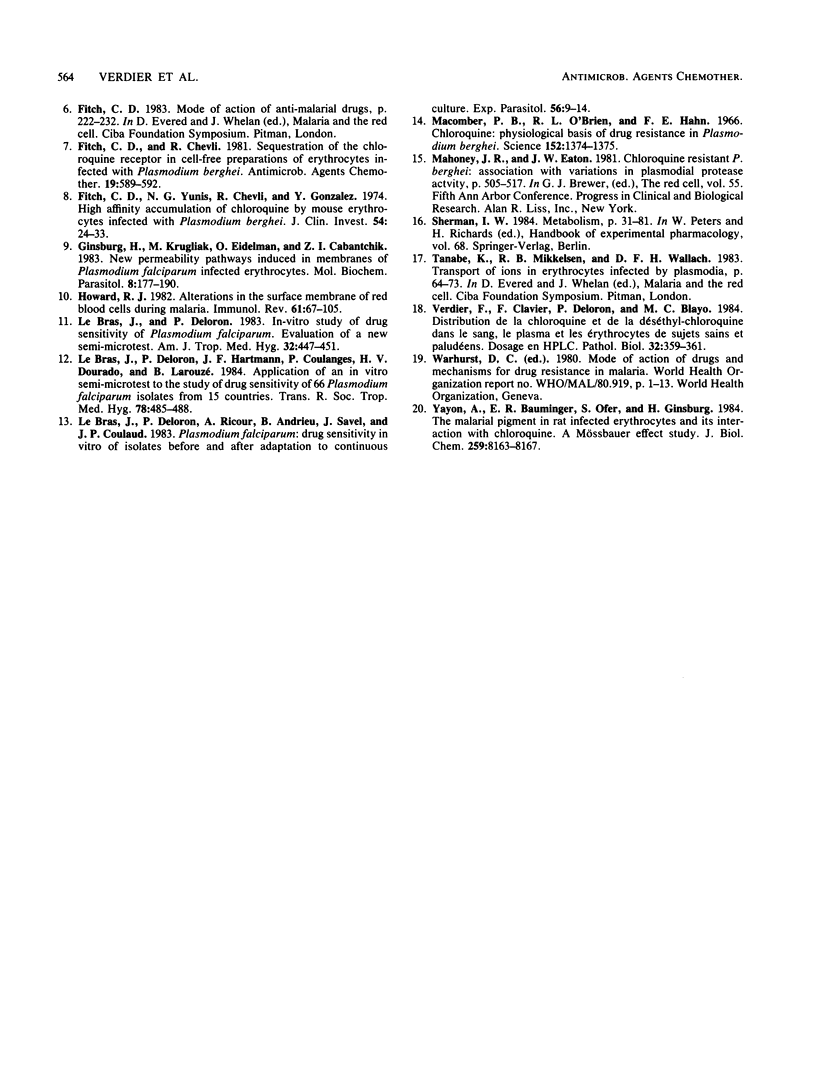Abstract
Chloroquine uptake by Plasmodium falciparum-infected human erythrocytes (RBC) was studied in vitro before and during culture by measuring the chloroquine gradient between the cells and medium (C/M) by high-pressure liquid chromatography. The C/M values were 5.9 +/- 2.7 (n = 23) for uninfected RBC, 13 to 34 for six chloroquine-susceptible isolates (concentration required to inhibit 50% of parasite growth, less than 100 nmol/liter) in partially infected RBC (parasitemia from 0.3 to 5%) (n = 28), and 8.4 to 4.9 for four chloroquine-resistant isolates (concentration required to inhibit 50% of parasite growth, 320 to 1,500 nmol/liter) in partially infected RBC (parasitemia from 0.4 to 5%) (n = 26). Two isolates were studied before and after adaptation to continuous culture. C/M was found to decrease (34.2 to 2.1 and 19.3 to 4.9), whereas the concentration required to inhibit 50% of parasite growth increased (35 to 1,400 and 54 to 1,500 nmol/liter), thus indicating the acquisition of chloroquine resistance. These results demonstrate that chloroquine uptake decreased in RBC in which the infective strain, initially susceptible, became resistant in culture and imply that the drug is bound to ferriprotoporphyrin IX to a lesser extent or that a parasite protein competes with ferriprotoporphyrin IX to a greater extent. We suggest that genotypic modifications in the mechanism of chloroquine uptake might occur in the parasite.
Full text
PDF



Selected References
These references are in PubMed. This may not be the complete list of references from this article.
- Aikawa M., Miller L. H. Structural alteration of the erythrocyte membrane during malarial parasite invasion and intraerythrocytic development. Ciba Found Symp. 1983;94:45–63. doi: 10.1002/9780470715444.ch4. [DOI] [PubMed] [Google Scholar]
- Banyal H. S., Fitch C. D. Ferriprotoporphyrin IX binding substances and the mode of action of chloroquine against malaria. Life Sci. 1982 Sep 13;31(11):1141–1144. doi: 10.1016/0024-3205(82)90088-1. [DOI] [PubMed] [Google Scholar]
- Chou A. C., Fitch C. D. Hemolysis of mouse erythrocytes by ferriprotoporphyrin IX and chloroquine. Chemotherapeutic implications. J Clin Invest. 1980 Oct;66(4):856–858. doi: 10.1172/JCI109925. [DOI] [PMC free article] [PubMed] [Google Scholar]
- Fitch C. D., Chevli R. Sequestration of the chloroquine receptor in cell-free preparations of erythrocytes infected with Plasmodium berghei. Antimicrob Agents Chemother. 1981 Apr;19(4):589–592. doi: 10.1128/aac.19.4.589. [DOI] [PMC free article] [PubMed] [Google Scholar]
- Fitch C. D. Chloroquine resistance in malaria: a deficiency of chloroquine binding. Proc Natl Acad Sci U S A. 1969 Dec;64(4):1181–1187. doi: 10.1073/pnas.64.4.1181. [DOI] [PMC free article] [PubMed] [Google Scholar]
- Fitch C. D. Mode of action of antimalarial drugs. Ciba Found Symp. 1983;94:222–232. [PubMed] [Google Scholar]
- Fitch C. D. Plasmodium falciparum in owl monkeys: drug resistance and chloroquine binding capacity. Science. 1970 Jul 17;169(3942):289–290. doi: 10.1126/science.169.3942.289. [DOI] [PubMed] [Google Scholar]
- Fitch C. D., Yunis N. G., Chevli R., Gonzalez Y. High-affinity accumulation of chloroquine by mouse erythrocytes infected with Plasmodium berghei. J Clin Invest. 1974 Jul;54(1):24–33. doi: 10.1172/JCI107747. [DOI] [PMC free article] [PubMed] [Google Scholar]
- Ginsburg H., Krugliak M., Eidelman O., Cabantchik Z. I. New permeability pathways induced in membranes of Plasmodium falciparum infected erythrocytes. Mol Biochem Parasitol. 1983 Jun;8(2):177–190. doi: 10.1016/0166-6851(83)90008-7. [DOI] [PubMed] [Google Scholar]
- Howard R. J. Alterations in the surface membrane of red blood cells during malaria. Immunol Rev. 1982;61:67–107. doi: 10.1111/j.1600-065x.1982.tb00374.x. [DOI] [PubMed] [Google Scholar]
- Le Bras J., Deloron P., Hartmann J. F., Coulanges P., Dourado H. V., Larouze B. Application of an in vitro semi-microtest to the study of drug sensitivity of 66 Plasmodium falciparum isolates from 15 countries. Trans R Soc Trop Med Hyg. 1984;78(4):485–488. doi: 10.1016/0035-9203(84)90068-3. [DOI] [PubMed] [Google Scholar]
- Le Bras J., Deloron P. In vitro study of drug sensitivity of Plasmodium falciparum: evaluation of a new semi-micro test. Am J Trop Med Hyg. 1983 May;32(3):447–451. doi: 10.4269/ajtmh.1983.32.447. [DOI] [PubMed] [Google Scholar]
- Le Bras J., Deloron P., Ricour A., Andrieu B., Savel J., Coulaud J. P. Plasmodium falciparum: drug sensitivity in vitro of isolates before and after adaptation to continuous culture. Exp Parasitol. 1983 Aug;56(1):9–14. doi: 10.1016/0014-4894(83)90091-7. [DOI] [PubMed] [Google Scholar]
- Macomber P. B., O'Brien R. L., Hahn F. E. Chloroquine: physiological basis of drug resistance in Plasmodium berghei. Science. 1966 Jun 3;152(3727):1374–1375. doi: 10.1126/science.152.3727.1374. [DOI] [PubMed] [Google Scholar]
- Mahoney J. R., Eaton J. W. Chloroquine resistant P. berghei: association with variation in plasmodial protease activity. Prog Clin Biol Res. 1981;55:505–518. [PubMed] [Google Scholar]
- Tanabe K., Mikkelsen R. B., Wallach D. F. Transport of ions in erythrocytes infected by plasmodia. Ciba Found Symp. 1983;94:64–73. doi: 10.1002/9780470715444.ch5. [DOI] [PubMed] [Google Scholar]
- Verdier F., Clavier F., Deloron P., Blayo M. C. Distribution de la chloroquine et de la déséthyl-chloroquine dans le sang, le plasma et les érythrocytes de sujets sains et paludéens. Dosage en HPLC. Pathol Biol (Paris) 1984 May;32(5):359–361. [PubMed] [Google Scholar]
- Yayon A., Bauminger E. R., Ofer S., Ginsburg H. The malarial pigment in rat infected erythrocytes and its interaction with chloroquine. A Mössbauer effect study. J Biol Chem. 1984 Jul 10;259(13):8163–8167. [PubMed] [Google Scholar]


